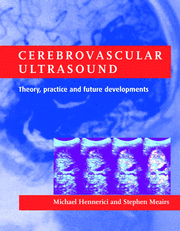Book contents
- Frontmatter
- Dedication
- Contents
- List of contributors
- Preface
- PART I ULTRASOUND PHYSICS, TECHNOLOGY AND HEMODYNAMICS
- 1 Introduction to Doppler ultrasound
- 2 Doppler technology
- 3 Principles and models of hemodynamics
- 4 Computational principles and models of hemodynamics
- 5 Flow patterns and arterial wall dynamics
- 6 Duplex and colour flow imaging
- 7 Misconceptions and artefacts in ultrasound examination of the carotid arteries
- PART II CLINICAL CEREBROVASCULAR ULTRASOUND
- PART III NEW AND FUTURE DEVELOPMENTS
- Index
3 - Principles and models of hemodynamics
from PART I - ULTRASOUND PHYSICS, TECHNOLOGY AND HEMODYNAMICS
Published online by Cambridge University Press: 05 July 2014
- Frontmatter
- Dedication
- Contents
- List of contributors
- Preface
- PART I ULTRASOUND PHYSICS, TECHNOLOGY AND HEMODYNAMICS
- 1 Introduction to Doppler ultrasound
- 2 Doppler technology
- 3 Principles and models of hemodynamics
- 4 Computational principles and models of hemodynamics
- 5 Flow patterns and arterial wall dynamics
- 6 Duplex and colour flow imaging
- 7 Misconceptions and artefacts in ultrasound examination of the carotid arteries
- PART II CLINICAL CEREBROVASCULAR ULTRASOUND
- PART III NEW AND FUTURE DEVELOPMENTS
- Index
Summary
Introduction
Cardiovascular diseases are the primary cause of morbidity and mortality in the western world. Complex hemodynamics plays a critical role in the development of atherosclerosis and in the processes of aging, as well as many other diseases. Biofluid mechanics plays a major role in the cardiovascular system and thus the term hemodynamics. It is important to understand the forces and movement of blood cells and whole blood, as well as the interaction between blood cells and the vessel wall. Genetic influences are also important. Fundamental fluid mechanics, which is important for the understanding of the blood flow in the cardiovascular circulatory system of the human body aspects is presented in this chapter, together with, some measurement techniques for model studies. A few applications of hemodynamic effects will be demonstrated in elastic silicon rubber models of the cardiovascular system.
Fluid
Biofluid mechanics describes the kinematics and dynamics of all body fluids in humans, animals and plants. Hemodynamics deals with the body fluids in humans. This chapter focuses on blood flow in the human circulatory system. Cardiovascular fluid dynamics is important for understanding blood and microcirculation (Hosoda et al., 1994; Liepsch, 1990a; Mosoro, 1984, Stein, 1981; Kerber & Liepsch, 1994; Skalak & Chien, 1986). A detailed understanding of hemo- and cardiovascular system dynamics is important for surgical techniques.
- Type
- Chapter
- Information
- Cerebrovascular UltrasoundTheory, Practice and Future Developments, pp. 25 - 62Publisher: Cambridge University PressPrint publication year: 2001
- 2
- Cited by



